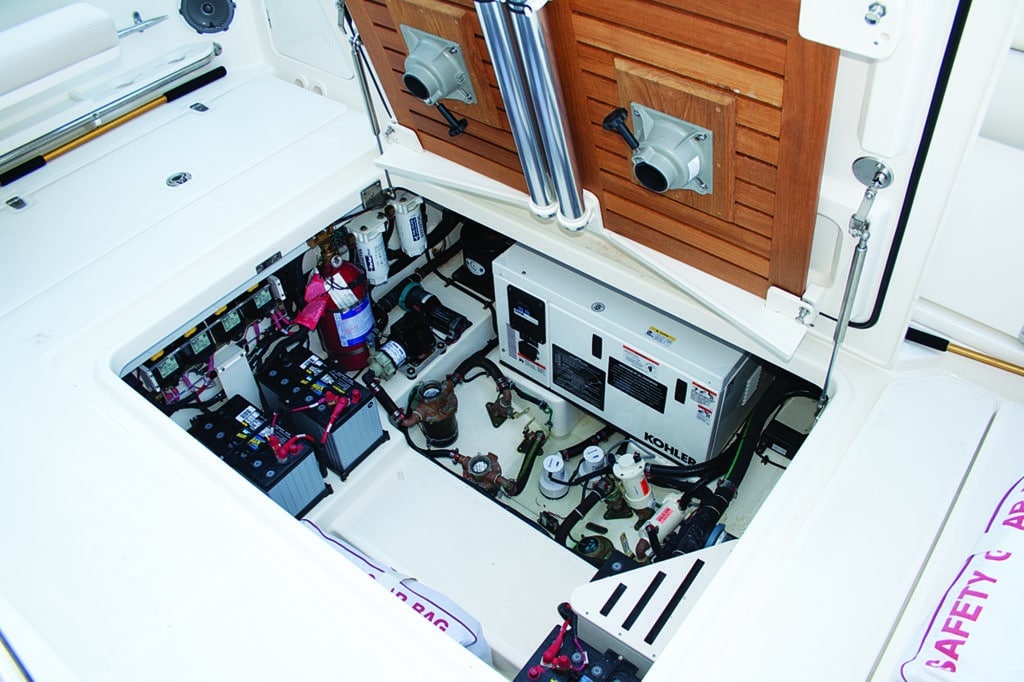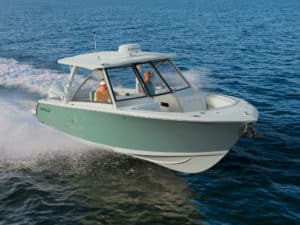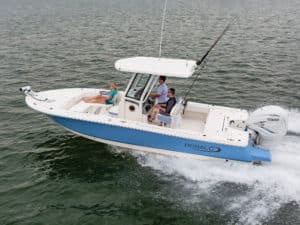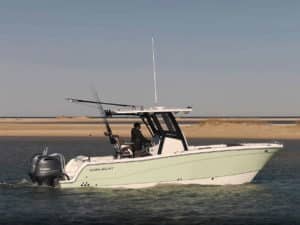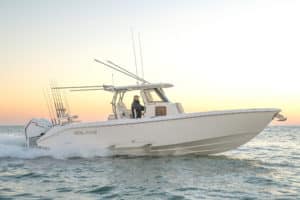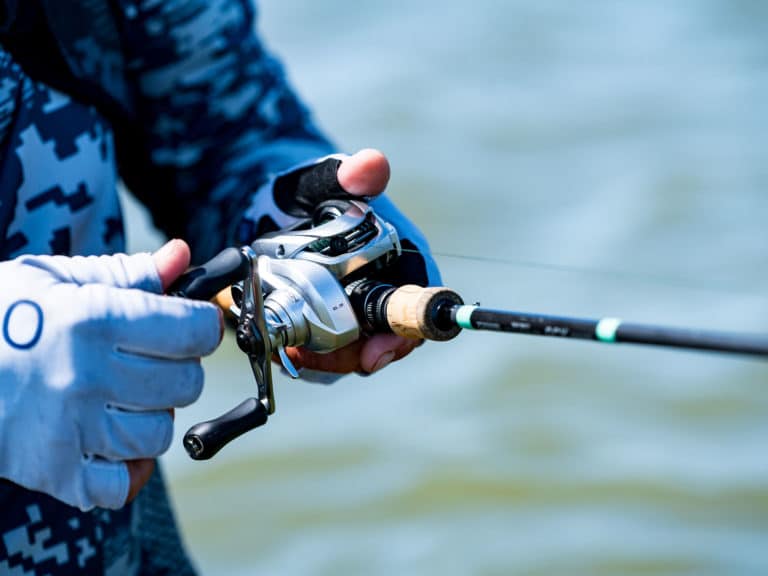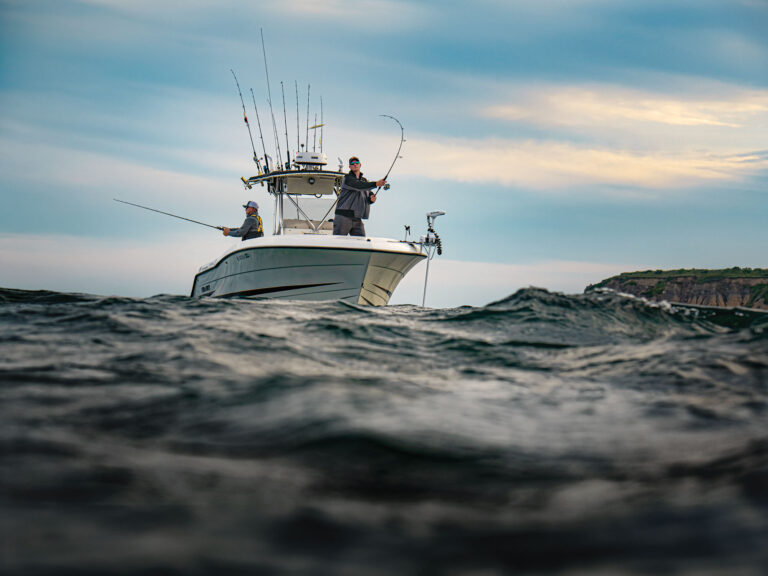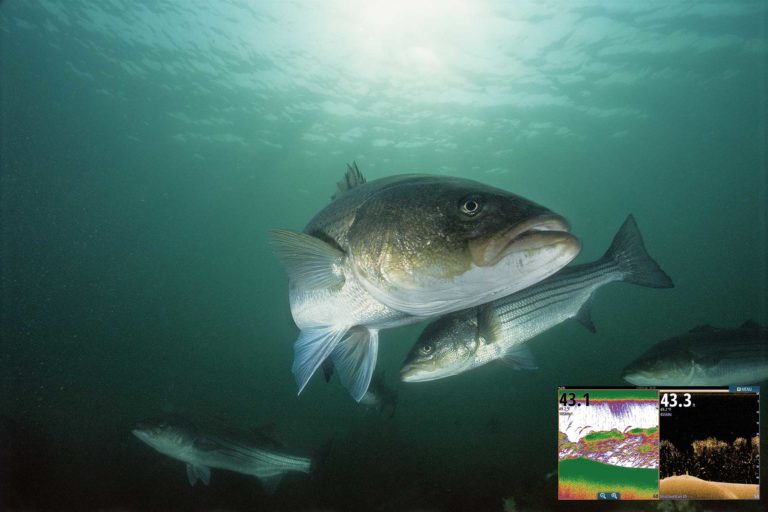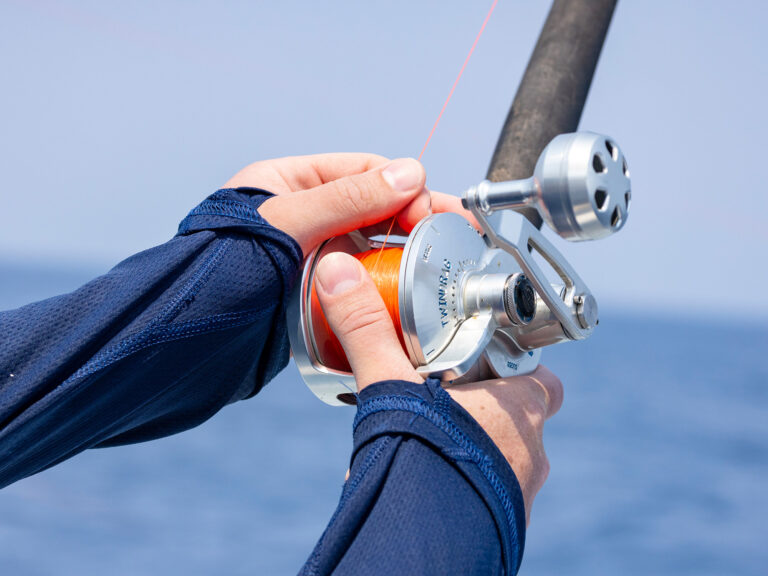“Mahi at 12 o’clock. Get a bait!” shouted Capt. Wil Rogers from the tower of Boston Whaler’s newest and largest center-console to date — the 420 Outrage — as we approached a floating bamboo log off the coast of Stuart, Florida. Crew members Ron Berman and Del Kelley each scooped up a live pilchard, deftly pinned them to hooks, and then hustled to the bow.
“Look, there’s a bunch of them,” Rogers pointed out. “Cast now!” Both anglers launched baits, which were quickly inhaled by hungry mahimahi below. Double hookup!
Little did I imagine this early April scene when I first saw a 4-foot scale model of the 420 Outrage 14 months earlier at the 2014 Miami International Boat Show. Now I was on the real thing — a supersized center-console that combines a wealth of offshore fishing features with sophisticated marine power systems and remarkable creature comforts.
Power Trip
Our trip had begun before sunrise as I met Berman, Kelley and Rogers at the marina. Rogers employed the joystick feature on the optional Mercury Outboard Pilot to extract the 420 Outrage from its very tight slip. As center-consoles grow ever larger, joystick steering is becoming more and more popular, says Rogers, who is the large-boat business manager for Whaler. Powered by a quartet of the new Mercury 350 Verado outboards, our course took us toward the St. Lucie Inlet. We made a quick stop to purchase three dozen live pilchards. The 40-gallon well in the rigging station held the baits nicely, as verified through the acrylic viewing window. Had we needed more room, the 420 has a 24-gallon well in the port quarter. Both tanks are pressurized to pamper the liveys.
One of the benefits of the new 350 Verados is better acceleration versus the 300s, said Rogers, as he advanced the Mercury digital throttle. With the quad 350s, the Whaler planes three seconds faster than the same boat using four 300s. The Lenco Auto Glide dynamic trim-tab system — an exclusive on Brunswick boat brands — also helps with the hole shot, creating extra lift during acceleration and optimizing trim while on plane.
The 42½-foot hull sliced smoothly through the oncoming 4- to 5-foot swells, thanks to a deep-V design with 22 degrees of deadrise at the transom. The 420 loped along at about 35 mph and 4,500 rpm with nary a thump or bump. Boston Whaler has eschewed the trend toward stepped-hull designs. “Comfortable speeds like this are where most of our customers like to run,” says Rogers. “You really need to run a lot faster to get the greater benefit from most stepped hulls, and in these sea conditions, you can’t run much faster without leaving everyone with white knuckles, steps or no steps.”
Enhancing that comfort, Whaler designed the three-across helm seats, each with a flip-up bolster for support while standing. In a Whaler trademark, a platform folds out from the seat base to give the captain and the co-pilot to starboard a bit more elevation and better line of sight. With the bolsters folded down, the seats provide excellent thigh support. Fold-down armrests and two tiers of angled footrests help keep you secure while seated behind the helm. The two outside seats can be swiveled aft to watch the trolling lines or mingle with guests.
A fold-out, forward-facing 58-inch-wide bench abaft the helm seats comfortably accommodates three or four crew members. This arrangement lets you converse with the captain and others seated in the front row. You can also fold the bench up and use it as a leaning post.
Amenities Galore
My test boat also included two air-conditioning systems, one for the cabin and another for the bridgedeck, powered while away from the dock by a Kohler 8 kw gasoline generator. While a diesel generator is available, Whaler research indicates that most buyers would rather avoid having two types of fuel, says Rogers. With the low carbon-monoxide emissions of today’s marine gasoline generators, gas issues are minimal.
A tempered-glass three-piece windshield envelops the helm and melds with the hardtop to protect the crew from blasting winds and errant spray. A motorized vent at the top of the front panel lets you usher in fresh air. On cool days you can further protect the bridgedeck with an optional rigidacrylic enclosure that extends to the 23-inch-wide aft hardtop supports on the gunwales. I took the lower-station helm and was pleasantly surprised by the ease of skippering this big boat. Part of this is due to the ergonomic layout of the helm, which aligns the wheel and Mercury DTS throttle with the center helm seat. The CZone switching panels are within easy reach of the helmsman.
This 420 came with three flush-mounted Raymarine gS165 15.4-inch displays, offering touch-screen access to the 1,000-watt fish finder, GPS and chart plotter, 4 kw HD radar with 4-foot open array, FLIR thermal imager, and SiriusXM satellite entertainment package, among other systems. The helm also included a Raymarine EV-400 autopilot with 3.5-inch color display, a Raymarine 260 module VHF and a Mercury SmartCraft VesselView display. Whaler allows you to customize the CZone digital switches on the 420 to suit your wishes via an app on a mobile device. The boat comes with a tablet just for this purpose.
Fishy Side
As we reached the 175-foot depth, the crew began deploying the trolling lures and baits from a pair of Rupp outriggers as the 350s turned 1,450 rpm for an 8 mph trolling speed, perfect for mahi. I noted that the 420 comes with five gunwale rod holders across the transom, and five more on each side of the bow for drift-fishing. There are also three angled rod holders on each of the aft hardtop supports.
With a 13-foot beam, the boat remained remarkably stable, whether trolling up-sea, down-sea or in the trough. That beam also allows for a huge aft cockpit, measuring 10½ feet wide by 5½ feet down the centerline. When you’re not fishing, family members can enjoy the two aft bench seats — one in the transom and another on the starboard side. A teak dining table in the cockpit lets you set up for entertaining. Once removed, it stows on the underside of the bilge hatch. The benches fold away quickly when it’s time to fish.
Also in the cockpit, a massive dive door on the port side simplifies the boarding process on floating docks and allows you to haul aboard big fish, as well as take a dip. A transom door in the starboard quarter offers access to the swim platforms, where a crosswalk joins one side to the other. Toe rails at the base of the inwales offer a high degree of safety when fishing along the rail. Aggressive diamond nonskid decks assure traction in wet conditions. Thickly padded coaming bolsters encircling the interior protect your knees and thighs from bruising.
Rogers used the rigging station to prepare ballyhoo for trolling. The station includes a drawer-style fridge on the starboard side with an electric grill above it. On the port side are drawers for tackle storage, and above that a faucet and sink. Of course, in the center is the aquarium-style livewell. The underside of the rigging station cover includes racks for paper towels, spools of leader material, pliers, and knives. Stainless-steel grab rails offer a place to hang on in rough seas.
To help shade the cockpit, my test boat featured a motorized awning that extends aft, a great benefit in the sweltering heat of summer. Later in the day, as the seas settled down, Rogers climbed up into the elevated second station. I found ladders leading aloft on all four supports. The tower features seating forward, allowing one or two crew members to help look for fish or soak up some sun from on high. My tester also came with a sunshade for the second station, and vertical storage for five rods abaft the seat back.
Comfort Zone
As we waited for a bite, I went below and was immediately struck by the immensity of the console cabin. Accessible via a companionway on the port side of the helm, this cabin features a teak dining table that lowers to support a filler cushion, creating a double berth. Whaler includes a fitted sheet, comforter and pillowcases as standard equipment on the 420. Skylights in the cabin feature integrated shade systems. A 26-inch display lets you watch sports, news or whatever your heart desires, thanks to the satellite TV system, which my test boat featured.
There’s also a galley with a countertop and sink, pressurized freshwater faucet, microwave, fridge and freezer, and both 12-volt and 120-volt power outlets. The head compartment features a VacuFlush toilet, shower, vanity with sink and freshwater faucet, and opening port light. All of the freshwater faucets offer both hot and cold water.
I returned topside and made my way to the bow along the 20-inch-wide walkways (which include two 9-inch step-ups). Forward of the console I discovered an inviting three-seat lounger with fold-out armrests, measuring 5 feet 9 inches wide by 4 feet 5 inches down the centerline. Below this lounger are two garages for stowing gear. U-shaped seating in the bow includes a retractable teak table. With the press of a switch, you can lower the table and add a filler cushion to create an expansive sunpad, or retract it completely to deck level and stow the seat pads for fishing action.
A cavernous anchor locker in the forepeak included a standard windlass with a roller recessed in the stem. A retractable freshwater washdown hose inside the locker lets you rinse off any bottom muck you drag aboard.
About this time, I heard Rogers excitedly calling out the position of the mahi. I grabbed my camera to photograph the action. Unfortunately, Kelley lost his fish, but Berman landed a 15-pounder. We iced the fish in one of the six in‑sole fish lockers that flank the deck of the 420, and rinsed off the slime with the raw-water washdown hose that pulls out from the retractable hose reel at midships. A second retractable hose provides hot and cold fresh water for washing down the deck.
Running Strong
By the time we cleaned up, it was time to head in and gather performance data in protected waters. With the quad 350 Verados, the 420 reached 30 mph in 9.9 seconds en route to a top speed of 53.6 mph at 6,400 rpm, with a fuel burn of 122 gallons per hour (0.44 mpg). By way of comparison, previous testing with quad 300 Verados resulted in a top speed of 50.1 mph at 6,300 rpm and a burn rate of 119.9 gph (0.42 mpg).
Optimum fuel efficiency with the 350s occurred at 4,500 rpm and 35.3 mph, where the 420 achieved 0.68 mpg. That equates to a maximum range of 408 miles, based on the 600-gallon fuel capacity. The 420 also proved more efficient than its sister with 300s, which posted 0.63 mpg at 4,500 rpm and 32.9 mph.
In many ways, Boston Whaler’s new 420 Outrage represents the pinnacle of center-console engineering, combining the latest in marine technology with Whaler’s legendary unsinkable hull construction, solid performance, and amenities that will please anglers and non-anglers alike. If you’re looking for a big family-oriented fishing machine, put the 420 on your list.
PERFORMANCE
POWER Four Mercury 350 Verado outboards
LOAD 300 gal. fuel, four crew
TOP SPEED 53.6 mph @ 6,400 rpm
TIME TO 30 MPH 9.9 sec.
BEST MPG 0.68 @ 35.3 mph (4,500 rpm)
HULL
LOA 42 ft. 6 in
BEAM 13 ft.
DEADRISE 22 deg.
WEIGHT 24,800 lb. (with power, fuel, water)
DRAFT 2 ft. 7 in.
FUEL 600 gal.
MAX POWER 1,675 hp
BASE PRICE $744,792 (with four Mercury 300 Verados)
Edgewater, Florida
877-294-5645
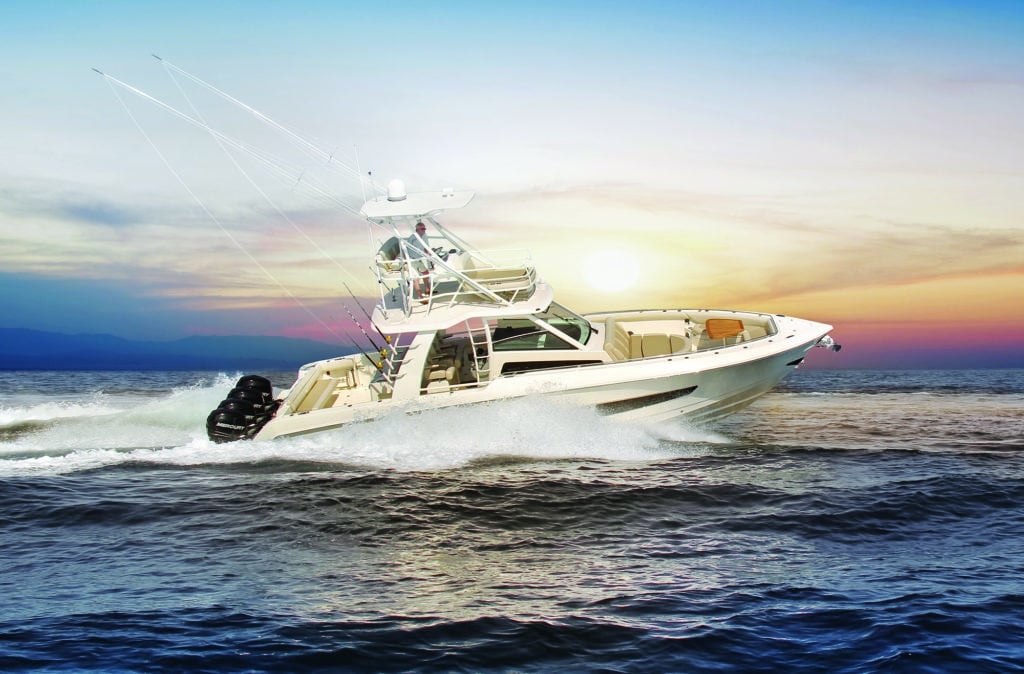
Boston Whaler 420 Outrage
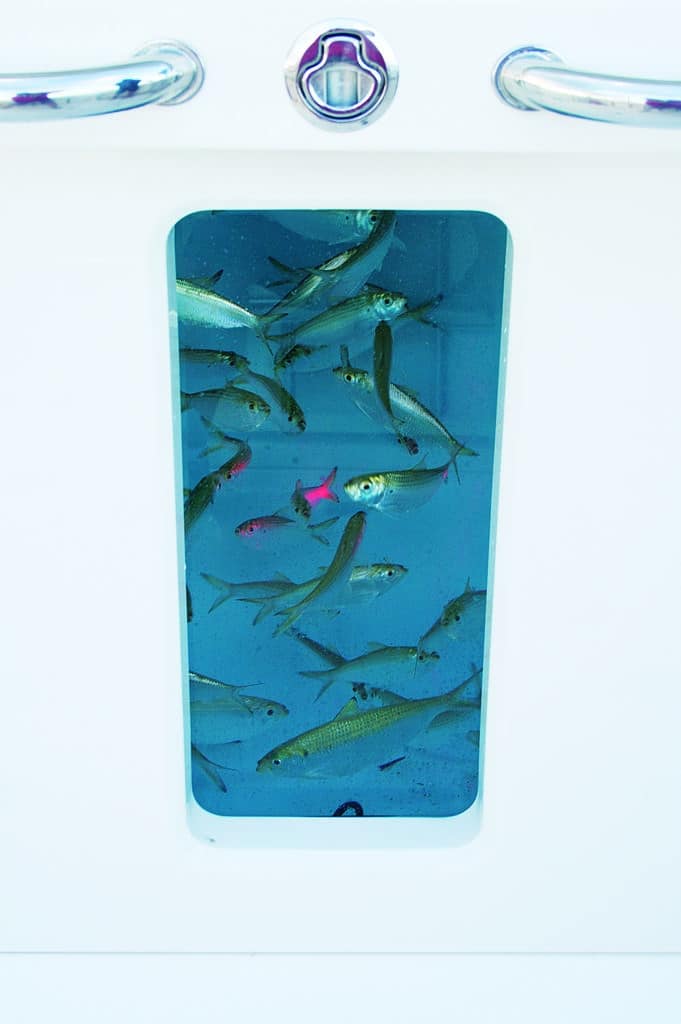
Boston Whaler 420 Outrage Livewell
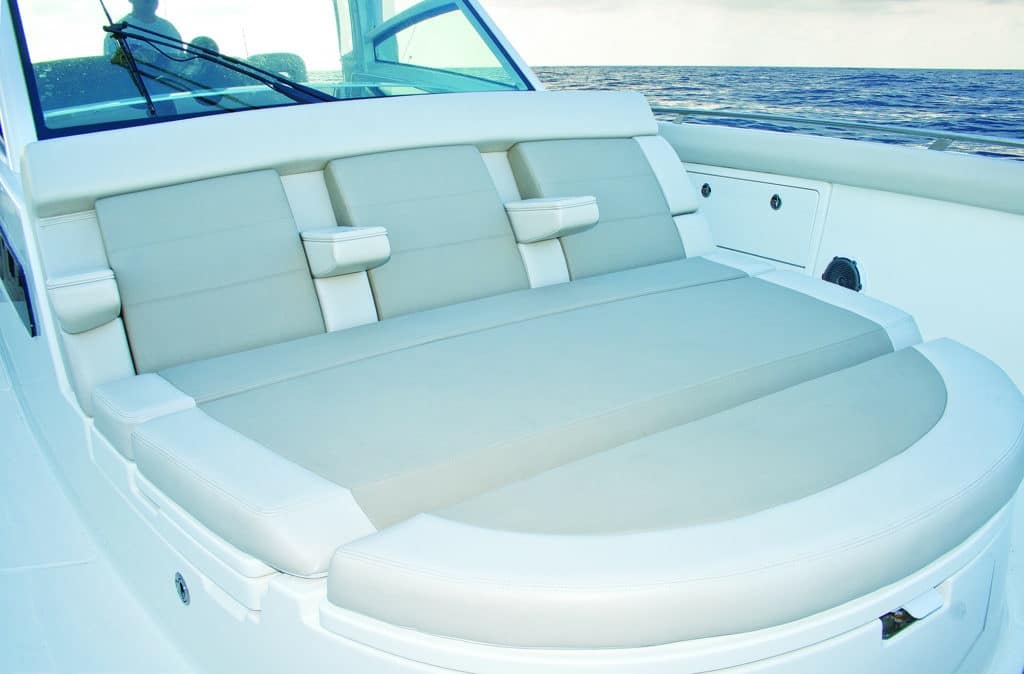
Boston Whaler 420 Outrage Luxury Features
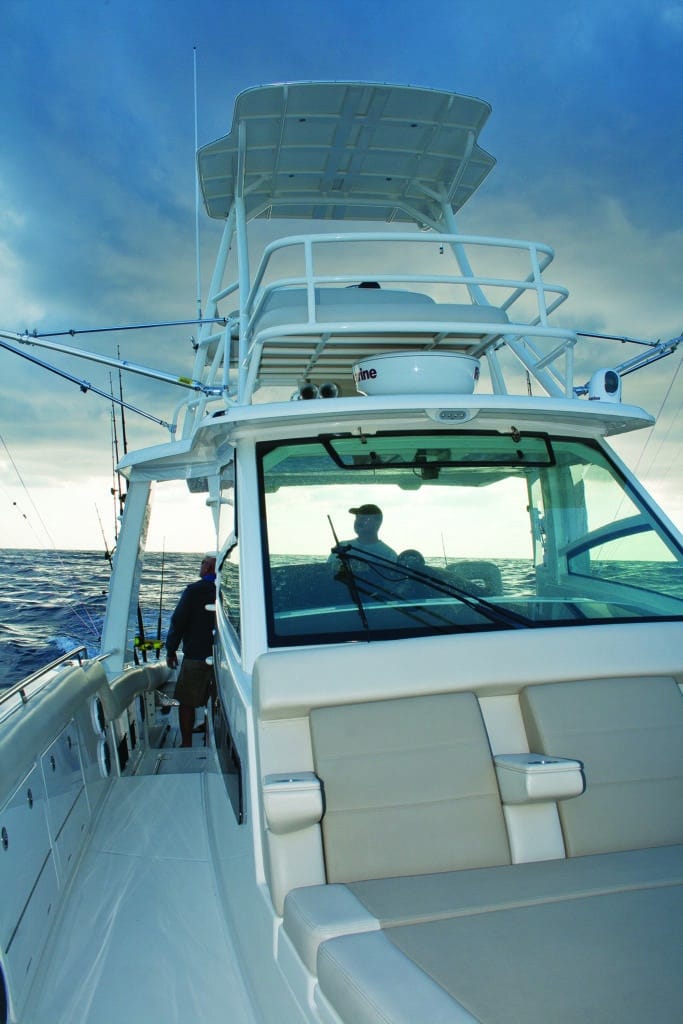
Boston Whaler Outrage
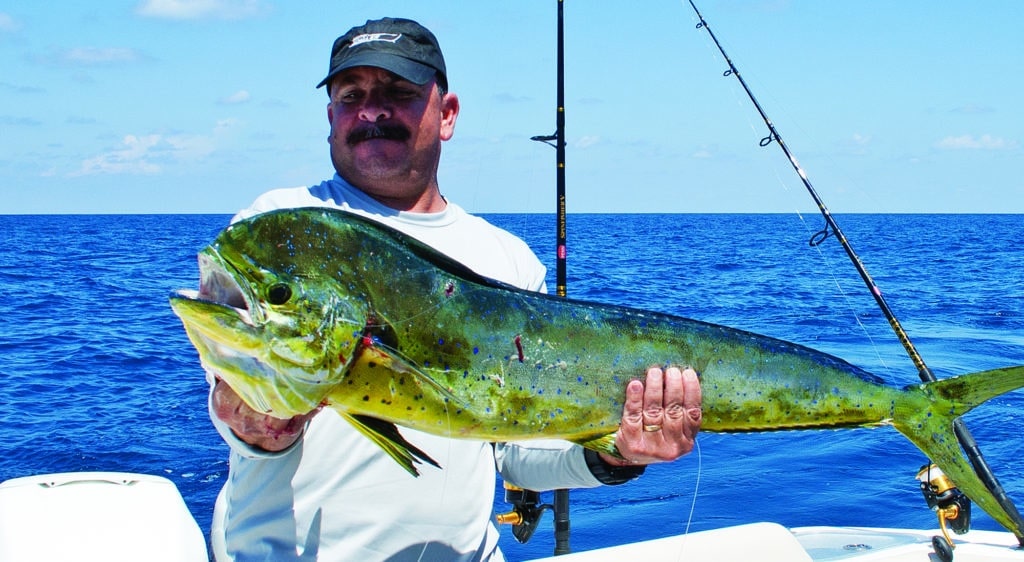
2015 Boston Whaler 420 Outrage Center Console
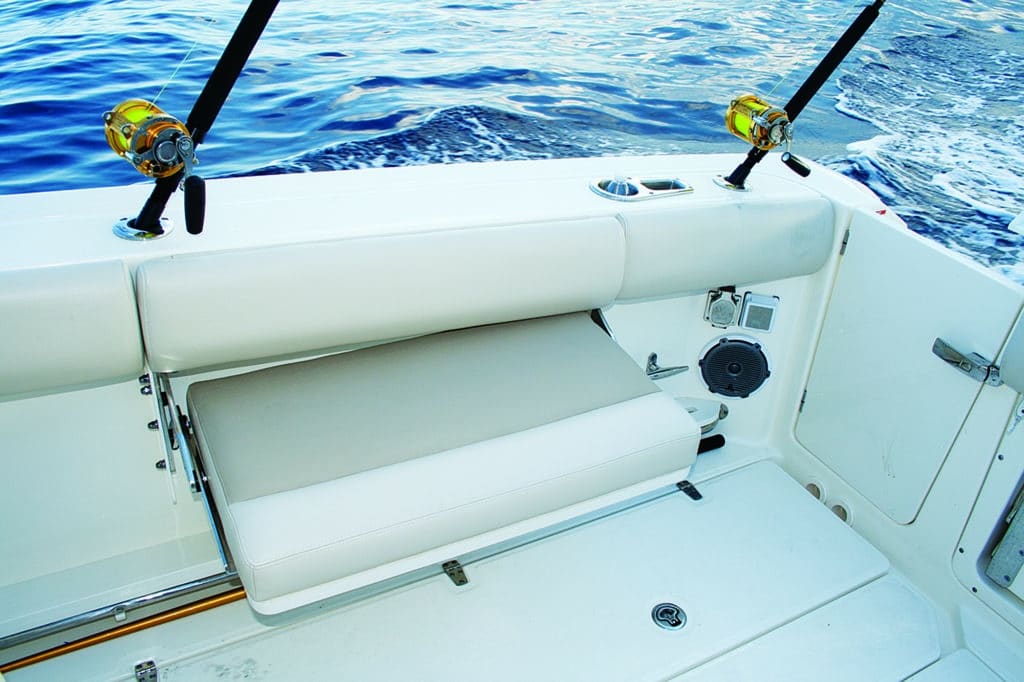
Boston Whaler Fishing Boat
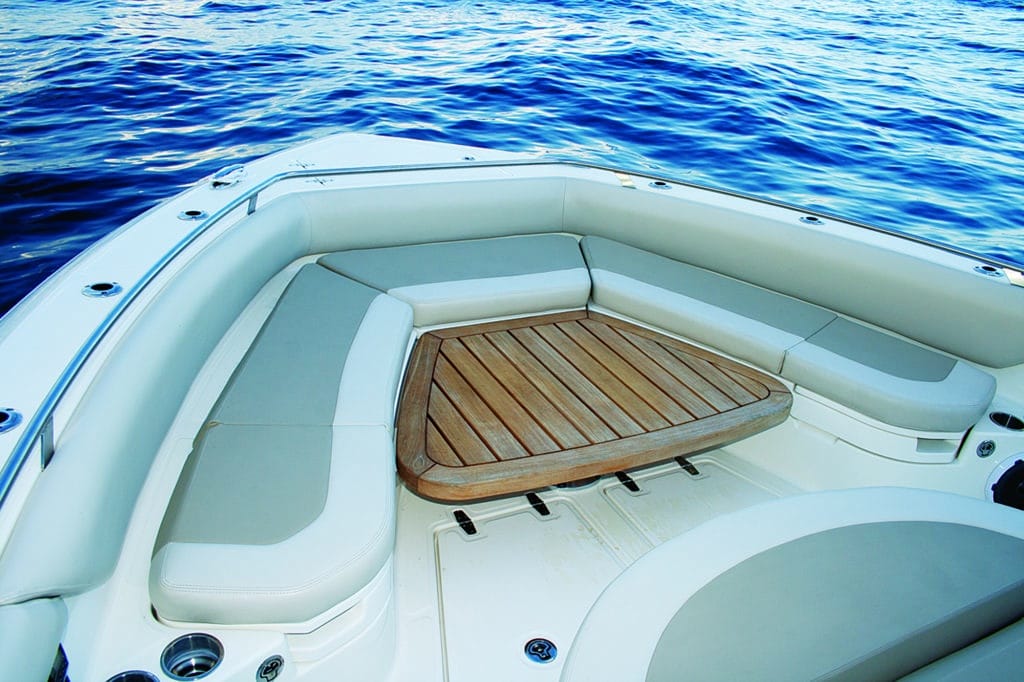
420 Outrage: The Largest Boston Whaler Ever
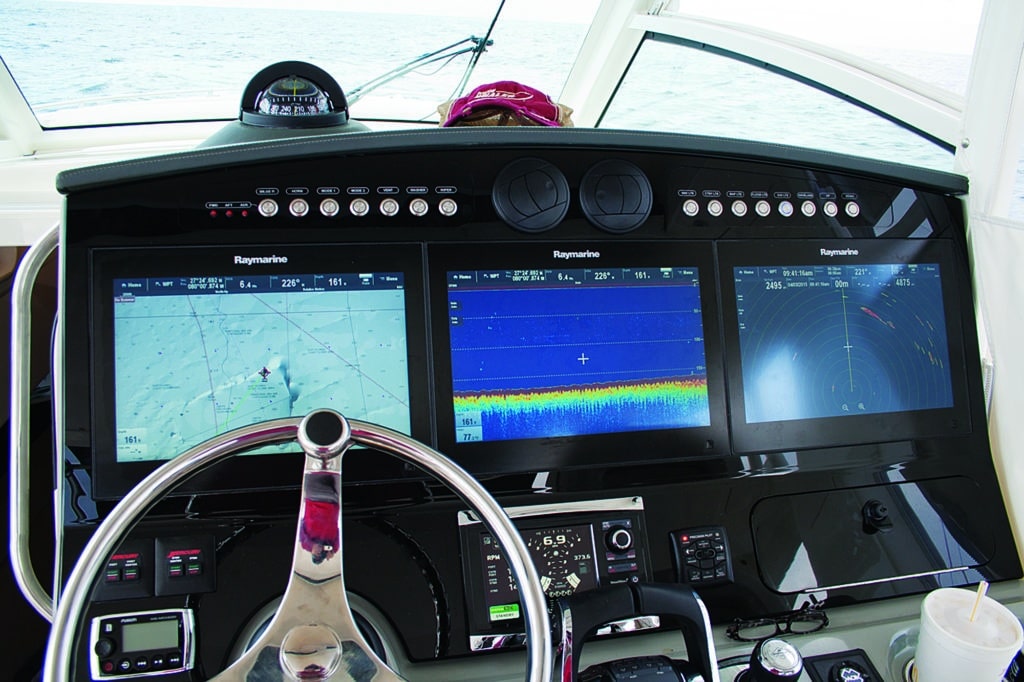
Boston Whaler 420 Outrage: Largest Model of All Time
